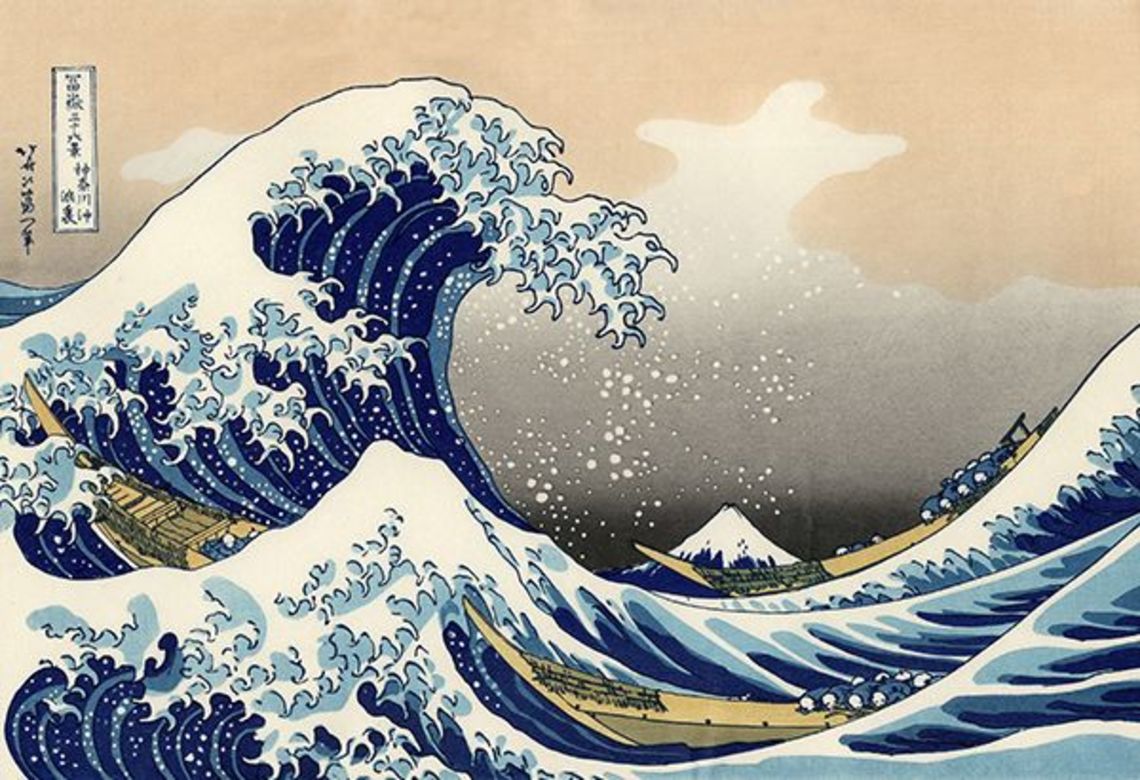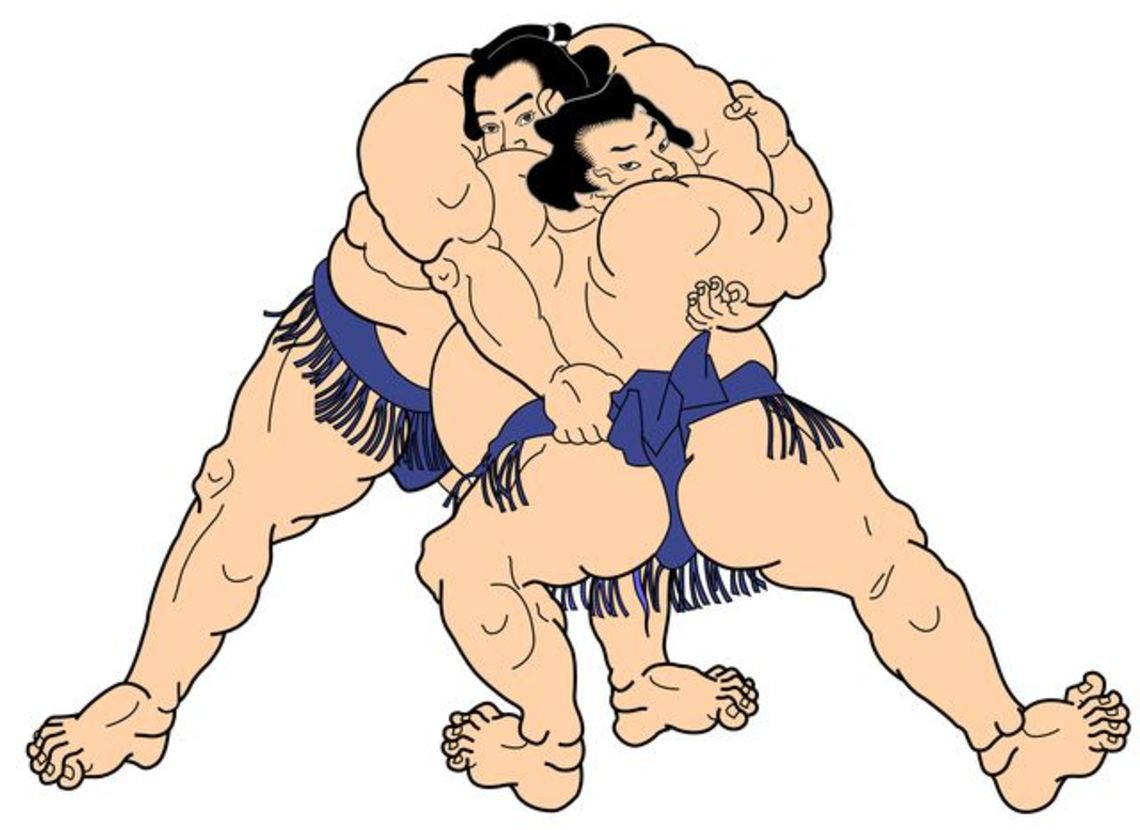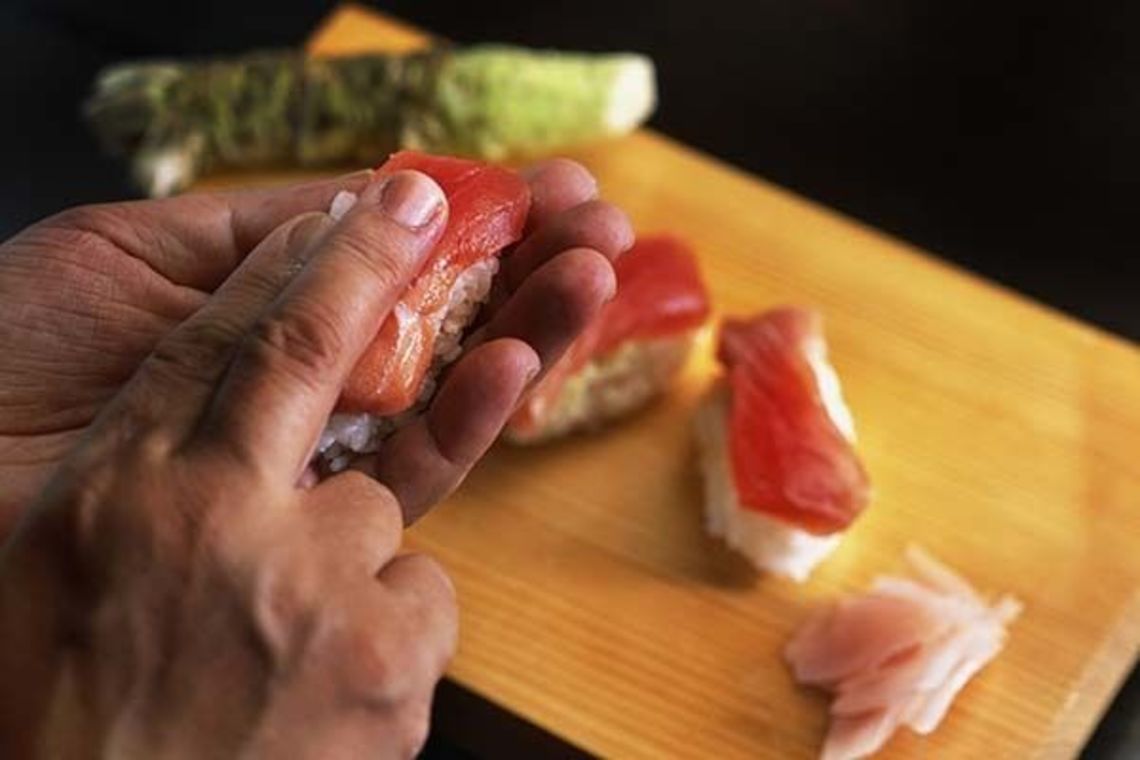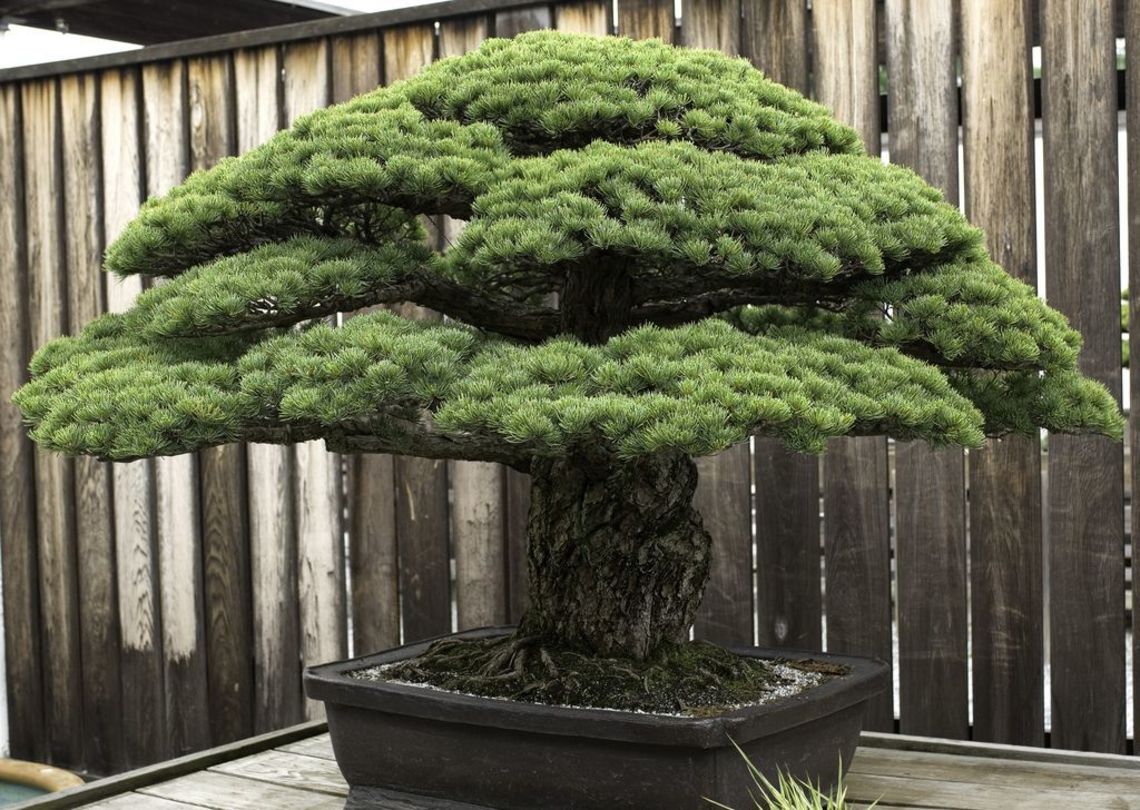
When we talk about Japan, it isn’t necessarily wrong to use familiar concepts like wabi-sabi and ‘fusion of tradition and modernity’ – it’s just that most people are probably tired of hearing these tropes. Here, I hope to leave these concepts behind and instead illuminate one major characteristic of Japanese culture, one that has developed over the past 400 years, and explain it through the idea of ‘zooming’.
The humongous and the minuscule
Japan is a relatively small island nation and – as you can tell by looking at Japanese rugby players – Japanese people are traditionally rather small in stature. Still, large things have obviously always existed in Japan, and these often seem to have been held in high regard.
Among the man-made objects that remain today, take the 5th-century rectangular tombs built for an emperor in western Japan, which are up to a kilometer long on one side. As for eastern Japan, one might mention the 17th-century Edo Castle – now known as the Imperial Palace – which sits right in the center of Tokyo but is surrounded by an over three-mile long jogging course.
Large natural objects are best represented by Mount Fuji (3,776m), once viewable from anywhere in Edo (Tokyo) and known as the city’s very own mountain. As Hokusai depicts in his ‘Thirty-six Views of Mount Fuji’ series, the peak was beloved by Edoites precisely for its majestic scale.
Even when it comes to human size, Japan has its giants: the average sumo wrestler weighs 150kg, and it isn’t uncommon for them to exceed 180kg. Although already retired, a wrestler called Konishiki weighed in at over 275kg – a fact that made him tremendously popular.
Then, with the Japanese being small people on small islands, is this appreciation of the large a yearning for what oneself doesn’t have? That could well be one explanation. But as the observant (and Japanese-speaking) among you may already have noticed, the aforementioned sumo wrestler’s ring name, Konishiki, means ‘small beauty’.
As you may well have heard before, subtlety and smallness have significant value in Japanese culture. For example, the famous netsuke are miniature sculptures, every piece of nigiri (sushi) is a tiny masterpiece, and rooms used for the tea ceremony are in some cases only 3.3 square meters in size.

So, how is it that these inclinations for both the big and the small, two opposing characteristics, can coexist? One of the cultural genres that best captures this idea of bipolarity is ukiyo-e (woodblock print) art. Ukiyo-e represent all things that exist in the ‘floating world’ (ukiyo), and portray anything and everything, though the most popular subjects are arguably Mount Fuji and human reproductive organs.
One is big, the other is small, but that’s beside the point: artists like Hokusai portrayed the large mountain as a small object between crashing waves or pieces of wood worked on by a carpenter – ‘zooming out’ and placing Mount Fuji in the background. On the other hand, in shunga (erotic art), the artist ‘zooms in’ on particular parts of human bodies, portraying these with great detail, down to individual hairs.
‘Zooming’ in and out of culture
Then, how are these two ‘zooms’ viewed in Japanese culture? I certainly shouldn’t need to explain how the zoom effect works with bonsai trees: you zoom out on a centuries-old pine, perhaps more than a dozen meters tall, and get a bonsai tree only 10cm high but grown with great care and dedication. Then again, looking at that same bonsai tree, you can zoom in and imagine a massive pine deep in the forest.
Likewise, over the past centuries, countless gardens covering dozens of acres were built by daimyo lords throughout Japan – Tokyo alone has more than ten of these – and some of them still remain today.
However, these gardens were not built simply to express grand scale and size. As is the case with bonsai trees, the gardens were built to replicate famous vistas in Japan: mountains, beaches and islands were built in miniature form. If you focus on any part of this vast scenery, you can zoom in and imagine a landscape dozens of times larger.
Moving on to another relationship that is, deep down, about more than just size, consider the extreme difference between enormous castles and tiny tea rooms, established over the past four or five centuries. I believe that by inviting the enemy general to a colossal, thousand-acre castle and then entertaining him in a 3m2 tea room, warlords assessed each other’s might and personality by zooming in and out of the world of battle. By zooming out on the vast castle and the battlefield where tens of thousands of troops did battle, and zooming in on each other as two human beings, the shoguns explored the possibility of reconciliation.

The effects of zooming appear in relation to a variety of phenomena in Japan. Japanese people employ the zoom effect on the aforementioned sumo wrestler, Konishiki. When I took an eminent American cultural anthropologist to watch sumo, he described the 275kg wrestler as ‘majestic’. As a fellow researcher of Pacific cultures, he knew that Konishiki was of Samoan descent, and presumably felt the wrestler possessed the dignity of Samoan royalty.
However, we Japanese do not feel the same. When we watch a big sumo wrestler, we are reminded of something that can be considered the opposite of ‘majestic’: an infant. For us, sumo wrestlers are innocent beings, who never say anything but ‘Thank you!’ and represent qualities best associated with small children. Zoom in on an infant and he becomes a sumo wrestler; zoom out on an almost naked sumo wrestler in his fundoshi loincloth and he becomes a baby.
Sushi: size matters
The zooming effect is found throughout Japanese culture, from theatre and fine art to kimono patterns. However, in order to make this reasoning more concrete, I’ll next take up a surprising example: sushi. Nigiri sushi, which traces its origins to Edo/Tokyo, has plenty of curious characteristics that often go unnoticed. Starting out as a fermented dish, sushi spread all across Japan – and, eventually, the entire world – only after shedding most of its fermentation-related attributes.
Now, however, let’s focus on the size aspect – for more interesting tidbits on this now-global delicacy, take a look at my previous articles in this essay series.

When it comes to sushi and size, the odd thing is that all nigiri more or less share the same proportions. Regardless of the original size differences of the seafood toppings, the size of the nigiri itself is always uniform.
The result is that huge tuna fish, some weighing over 200kg, are cut into small pieces, while dozens of tiny shrimp no larger than half an inch are clumped together, all to match the uniform slab of rice on which they’re to be placed. When Japanese people eat nigirizushi, they enjoy more than just the taste – the size is equally important, as it allows for plenty of zooming. Both the giant tuna and the tiny shrimp can be eaten in the exact same way because of how nigiri are standardized.
Get lost in Tokyo
To summarize, the pleasure of zooming in and out – be it in relation to bonsai, sumo wrestlers or sushi – is a common technique that highlights a central aspect of Japanese culture. Now, before I wrap up, I’d like to pass on a few tips on how to make you even more excited about exploring Tokyo. My recommendation when visiting the city would be to simply ’get lost in Tokyo’.
Tying in with my earlier discussion of size, it’s worth mentioning that Tokyo is, most likely, the largest city in the world right now, both in terms of population and size of urban area. Some visitors may be discouraged by this, as knowing where to go can be a real challenge.
However, trust me on this: public transportation, from subways to taxis, are clean, punctual and cover the entire region, allowing you to get from almost anywhere in the city to almost anywhere else within 20 to 30 minutes. And as you might have guessed, the vast, highly advanced, village-like city incorporates ‘zooming’ into its structure. Knowing this is key to exploring Tokyo.
Zooming in Tokyo refers to specific urban activities being centered on specific areas. Think of a Broadway theatre in New York, or perhaps a Soho porn shop. In fact, Tokyo has several quarters that are many times larger than London’s Soho. There’s no need for me to go into those details here, but the point is that Tokyo has a multitude of areas that have developed around specific activities.
There’s the bookstore district, with nearly 200 secondhand book shops. Books in Japanese might not be very interesting for overseas tourists, but how about a town packed full of shops dealing only in kitchenware? Or perhaps the electronics district, the musical instrument district, the anime merchandise neighborhood or the center for youth fashion boutiques?
Take the train from Tokyo for 30 minutes and you’ll arrive at a place packed with bonsai shops and museums. And of course, there are probably at least a dozen eatery quarters in Tokyo boasting hundreds of restaurants, bars and Japanese-style pubs.

Compared to other cities, Tokyo stands apart in the scale and density of its clusters. By entering districts such as the kitchenware and electronics areas, with their vast lineups of stores selling similar things, consumers in Japan are zooming out and enjoying the scale before zooming in and choosing a specific shop to enter.
Of course, looking for a specific secondhand book or clothes from one’s favorite brand is just like shopping anywhere else. What’s different, however, is when you enter a certain specialist area, zoom out by placing yourself in a world of tens of thousands of bonsai trees, and then find and zoom in on a single tree. This lends an entirely new dimension to your shopping experience.
Where will you go in Tokyo? Chances are you’ll get lost. That, though, may be a great way to enjoy the city’s diversity. Considering the excellent travel infrastructure, smartphones, and Japanese people’s kindness, I feel confident in telling you: please get lost in Tokyo – it’s the best way to savor everything the city has to offer.
(Written by Takeo Funabiki)
Related articles from Time Out Tokyo The best sports for plum-viewing in and around Tokyo Ten of the coolest Airbnb rentals in Japan Onsen etiquette

